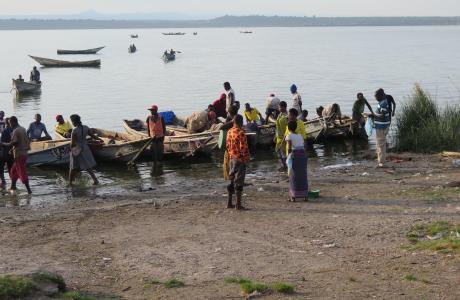Understanding tree growth for the sustainable management of a popular tropical timber species
Afrormosia is among the most exploited timber species from the Congolese rainforest. However, as the trees suffer from regeneration problems, overexploitation may jeopardise the survival of the species. To develop a more sustainable management, researchers are trying to understand the tree's growth pattern through experimental plantations.

The Nelder wheel experiment at the Compagnie Foresteièe et de Transformation (CFT) in Kisangani, DRC, to investigate the impact of distance on tree growth and mortality. © Axel Fassio/CIFOR
Popular but vulnerable
Afrormosia (or Assamela, Pericopsis elata) is a flagship hardwood native to Central and West Africa, and is one of the most harvested and most valuable in the DRC. Thanks to its exceptional properties it is very popular for instance with furniture makers and interior designers and architects (for parquet floors, terraces, window frames, etc.)
Afrormosia, however, is potentially very vulnerable. A light demanding species at a young age, it does not regenerate well naturally in Central Africa’s closed canopy forests. Meanwhile, its trees are being increasingly harvested, more and more under the radar of the authorities, jeopardizing its very existence.
The species is therefore classified as endangered on the Red List of the International Union for Conservation of Nature (IUCN) and its international trade is regulated by the Convention on International Trade in Endangered Species of Wild Fauna and Flora (CITES).
Nelder experiment
A better understanding of how afrormosia regenerates and how to support its regeneration process can contribute to the protection of the species.
To unravel the tree's growth pattern, researchers from the RMCA, CIFOR (Center for International Forestry Research) and R&SD (Resources and Synergies Development) are carefully studying the growth of afrormosia trees on a plantation in Kisangani (DRC). The researchers are using so-called Nelder wheels, an experimental setting where trees are planted in concentric circles. Trees in the centre are very close to each other, and are planted farther away from each other as the radius of the circle expands outwards. In this way, the researchers can assess the impact of distance on tree growth and mortality. This will allow researchers to provide foresters with guidelines on how to efficiently plant seedlings of the species.
The effect of the distance between the trees is obvious: the trees in the middle are much taller than those on the edge, which are shorter but have thicker stems and more branches (where competition is less). The trees in the middle have to compete with each other for sunlight. Some of them will probably die, due to a lack of light. This, in turn, promotes the growth of the surrounding remaining trees. According to the Congolese law, an afrormosia has to grow for about 80 to 120 years before it can be harvested.
Towards a more sustainable logging industry
For this experiment, it was important for the researchers to collaborate with the Congolese logging company Compagnie Forestière et de Transformation (CFT), on whose concession the Nelder plots are located and with CFT assuming the responsibility for the care of the trees. The seedlings were also provided by CFT’s tree nursery, established in collaboration with the RMCA through the DGD-funded GeForCo project. The aim of this cooperation, now within the framework of the EU-funded FORETS project, is that in the future CFT (and other logging companies) can integrate afrormosia plantations into their activities for the production of wood.
"This experiment is of great importance to the logging sector, as it can determine the ideal distance that should be left between trees when planting. Tall, thin trees are not ideal for sawing. Medium-sized, thick trees without low branches can produce larger, more commercially interesting boards," explains forestry expert Nils Bourland (RMCA, CIFOR and R&SD). "Moreover, the insights from our research could guide selective logging, cutting only some trees, while leaving others to grow."
The collaboration with CFT is unique and their commitment to a more sustainable approach is promising. "We would like to see more companies take similar steps," says Nils Bourland. "The DRC is home to 60 percent of Africa’s most important tropical forest, the Congo Basin – yet its logging industry is lagging behind other countries in the region in terms of sustainability. More and more of this precious timber is being harvested by a huge and practically uncontrolled artisanal sector. This needs to change."
 Afrormosia seedlings at the CFT, Kisangani © Axel Fassio/CIFOR
Afrormosia seedlings at the CFT, Kisangani © Axel Fassio/CIFOR
 Wood transformation at the CFT, Kisangani © Axel Fassio/CIFOR
Wood transformation at the CFT, Kisangani © Axel Fassio/CIFOR
Article based on and adapted from: Rooting sustainability in the logging industry by Athziri Gonzalez for CIFOR.
Want to know more about afrormosia and CITES? Listen to this podcast episode with Nils Bourland:


